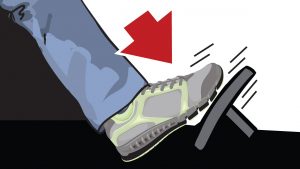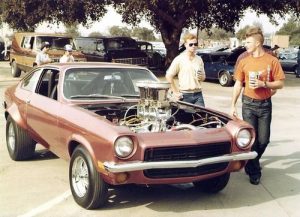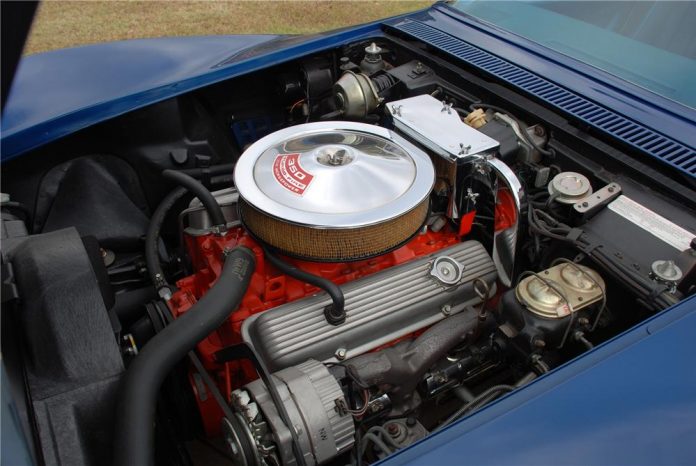You don’t see a lot of things in new cars that were once common to almost all cars. It can be fun to remember – and if you don’t, to hear about the way it used to be. In no particular order of preference, then:
Round air cleaners –
Most cars today have square ones that install in an air box – literally. The lid usually held on by snap-clips or plastic screws. The box is usually offset to the side of the engine – and almost always generically ugly. Boxes – and flat air filters – became common as fuel delivery systems transitioned from mechanical mixation (carburetors) to electronic fuel injection. Some of these boxes have electronics, too. Airflow sensors and such. They are hard to get emotionally excited about – beyond cursing how hard it can be to get the snap-on lid snapped back on again.
Round (and made of metal) air cleaner assemblies sat on top of the engine, which is aesthetically more coherent. Even more so when the lid was chrome-plated and there were attractive and suggestive cross-flagged stickers and engine displacement callouts on them. They were held in place by a single wing-nut that threaded onto a stud that screwed into the carburetor’s base – right down its throat.
Sometimes, the air cleaner was open – with the lid just covering the top – so as to let the engine breath. If the factory didn’t make it that way, you could – by flipping the lid upside down.
Just loosen the one wing-nut and let the secondaries roar! Speaking of that . . .
Secondaries –
In new fuel-injected cars, when the driver floors the accelerator pedal, an electronic signal is sent to the computer, which instructs the electronic fuel injectors to spritz more pressurized gas into the cylinders. In a pre-EFI car with a carb, the gas pedal connects to a box made of aluminum or similar filled with raw, liquid gasoline.
When the pedal is depressed, it causes one set of metal flaps within the carburetor to open a bit, which draws in more gas – and air – via the negative pressure created by the running engine, which almost literally breathes in the fuel and air. When the pedal is floored, the secondary flaps open – which opens the engine to the atmosphere creating a kind of vacuum cleaner effect and a sound that no fuel-injected engine can make.
Especially if you’ve flipped over the air cleaner lid.
Brakes that lock –
It’s been about 30 years now since anti-lock brakes (ABS) became standard equipment in most cars – and braking began to become a lost art. In ABS-equipped cars, the driver just pushes the brake pedal all the way to the floor – and the ABS brakes the car. The wheels won’t stop rotating altogether – preventing the tires from leaving black marks all over the road and the car from skidding in whatever direction it was headed.
This is regarded as a “safety” advance. Which can be seen in the same light as wearing diapers so as not o worry about needing to make it to the bathroom in time.
When brakes could be locked, it was possible to perform a controlled skid. You see this still in movies – in which the ABS has been disabled. And you could stop better (faster) on ice – if you knew how to brake. ABS doesn’t – and just keeps you rolling…
Interchangeability –
It was once the case that if you could make it fit, you could probably make it work. The engine from that car could be installed in this car – or rather, would work in this car, provided it all bolted up. This was both fun as well as practical. Fun, to see what you could make work – a classic example being the installation of a big block V8 (for the young who missed out on this, a “big block” was a very large displacement engine that was also physically larger than a small block V8; e.g., a 454 Chevy big block as opposed to a 350 small block) in a very small car, such as a Vega.
The result may not have been “safe” – but it was a helluva lot of fun!
As far as practical: If you had a car that had a bad engine or a croaked transmission you could replace either with any of several similar, not necessarily the same – from different years and even different models than your particular car. Such interchangeability was easy – or at least, doable – because in those days, the parts weren’t electronically connected to a computer and specific to that particular car.
No safety net –
Before there were such things as anti-lock brakes and traction control, it was expected that drivers control their cars. That safety was a function of paying attention – and skill. Interestingly, this resulted in better – safer – drivers, for the most part. Because most people hesitated to tailgate when they knew they could not stop in time, if the car ahead did – and they would skid right into it (or off the road). They learned to handle driving in snow – because if not, they could not.
Backing up over kids was uncommon – in the first place, because people could see what was behind them, the government not yet having endowed cars with raised-gorilla-in-rut behinds that are difficult to see behind – and in the second because it was expected that a driver look before reversing.
Today they wait for a beep to tell them to brake.
. . . .
Got a question about cars, Libertarian politics – or anything else? Click on the “ask Eric” link and send ’em in! Or email me at [email protected] if the @!** “ask Eric” button doesn’t work!
If you like what you’ve found here please consider supporting EPautos.
We depend on you to keep the wheels turning!
Our donate button is here.
If you prefer not to use PayPal, our mailing address is:
EPautos
721 Hummingbird Lane SE
Copper Hill, VA 24079
PS: Get an EPautos magnet or sticker or coaster in return for a $20 or more one-time donation or a $10 or more monthly recurring donation. (Please be sure to tell us you want a magnet or sticker or coaster – and also, provide an address, so we know where to mail the thing!)
My eBook about car buying (new and used) is also available for your favorite price – free! Click here. If that fails, email me at [email protected] and I will send you a copy directly!












That’s why I’m searching for either a ’73 Satellite Sebring, 2-door, with a 360 or 400, or a ’72-’74 Chrysler Newport with a 400 or 440 and all the “bells and whistles”, interior in reasonable condition with all accessories at least there. If the plant’s tired, I can do something with it; that’ll factor into the price. Nothing like driving your living room couch around.
I learned how to drive on Minnesota ice without ABS. I am in my 60’s. I hate ABS in cars . It’s ok on my BMW street bike, but that thing doesn’t get ridden in the winter.
Hi Anon,
Same. I dislike ABS for the same reason; I can drive and don’t need it. I also don’t need the extra parts and potential costs that come with it. The BMW R18 T bike I’m testing out this week has the damned electronics, but they can be turned off. I wish that were the case in cars.
Hi Eric,
I disconnected the ABS module in my car a couple years ago after it almost caused me to rear-end somebody. The dash light is annoying and I have to reconnect it when I go for the saaaaafety sticker but at least now I’m in control of the brakes.
Eric, I miss a foot controlled high beam switch. To many functions of the damn stem turn signals now.
Amen, Fool!
One of the many reasons I love my ’76 TA is that it has a foot-operated high beam switch.
Don’t tell me, let me guess…”Goofy foot” pedal on the hi beam switch, right?
Questions:
What about cars that have fuel injection but still have a manually controlled plate with the throttle cable in the throttle body? IE, not drive by wire. Does the gas pedal actually only control the amount of air allowed to flow into the engine?
Also, are the secondary flaps controlled entirely by the position of the pedal/throttle cable, or something else?
Never turned the air cleaner top upside down. I wish I had.
As for ABS – I used it once & it didn’t work.
took a shortcut over a mountain pass dirt road hunting one morning.
It snowed a few days before & once I topped the mountain and headed down the north side, I discovered it was all ice, a bit too late.
Hit the brakes & all that did was make my Blazer start to fishtail – ABS my ass.
I took a ride a few hundred yards down that mountain pumping those brakes and steering into the skid until I hit a flat spot, where I could finally get stopped.
Somehow didn’t hit a thing.
All that time fooling around in snowy empty parking lots with basic cars paid off.
Not sure what
Heres another garbage aspect to modern air filter boxes- the rubber snorkels all eventually tear. This is due to the idiotic design of letting the engine rock on rubber or hydraulic mounts while holding the air box stationary with the body. A tear not only lets rubbish unfiltered air in to sandpaper your engine it also triggers the money light to fail your inspection and can cause havoc with idle air control and air fuel ratios. Theres usually no good repair other than a potentially expensive replacement specific to your make and model. The worst air leak the old pancake atop the engine could manage was a damaged flat gasket or rubber ring that could be made at home in a pinch. The box filter housings also break and flop around post filter letting in the same gritty air with the bonus of fouling your mass air sensor if you’re unlucky enough to have one. They also seem to be rodent magnets which doesn’t seem as much an issue with the old tried and true filter housings. Perhaps engineers should work on new inventions rather than sabotaging solid designs that work.
Agree about that. The excuse “it has to fit somewhere once we made that gnarly intake plenum” doesn’t wash. The simplest design, therefore, the automakers won’t do it, would be on a Vee-type engine (V6 or V8) to just leave room for a cannister-type round filter at the entrance. Eezee-Pleasey-Jap-on-eezy. An inline engine would not be any tougher, as typically, with a smaller displacement (most inline fours are no bigger than 2.2 liters, to avoid need for a “jackshaft”), there should be room where the intake side is.
And the other issue is that the snorkel can simply be made THICK enough, with an accordion style section, to FLEX enough that if a mount for the air box, affixed to the chassis, were indeed needed due to space constraints. Also, getting TO than Gott-Damned filter! What’s with those stupid snaps which seem to inexplicably fly off and end up in some crevice of the engine compartment or frame where it’s as good as gone? Or using screws fastened directly into the plastic housing, which will STRIP so easily. It’s as if the engineers wanted to ensure that the contraption would hold up reliability during the one-two filter changes that’s necessary to get through the engine-powertrain warranty, but once that’s gone, it’ll give out well before the engine’s actually worn out. More annoying shit to cause you to scream, “Aw, FUCK IT!” and go back to the “stealership” for another round.
I remember growing up in the 90s being confused why some in my parents’ generation loved CARS so much, or were “Car guys.” I thought cars were lame, and still do for newer ones. Now I know why.
Seeing a car or truck from the 30s, 40s, or 50s though is a thrill and something to get excited about. Beautiful, functional, and cool!
There were still engineering and manufacturing improvements (and also in the products that the Petroleum industry offered, especially in engine and gear oils) yet to come after 1959 (the year that I was born, BTW).
Truth is, most Chevys-Fords-Plymouths were junk after 75K or so miles, unless lovingly maintained by a shade tree mechanic that knew what he was doing. My grandparents had a 1941 Plymouth that, having been wrecked three times, was all but indestructible, and still ran well (but looked awful, I’ve seen the pics) by the time my grandmother convinced Grandpa to buy her a new car – I think it was 1957 or so by the time they gave it to some Mexican farm kid that had worked for them and was going into the Army. From what I’ve heard when he’d done his hitch, the ’41 Plymouth was STILL “soldering” on! But that’s probably b/c he was also a good mechanic, and Grandpa, some years later when I was a wee lad, spending time with him out on the “ranch”, wished he had “Roberto” back.
Else, most of the cheaper lines were ready for the scrap heap at less than 100K miles. The converse was that most folks put on much less MILES back then. My other grandfather, a boiler inspector that had accounts to service all over the West Coast for an insurance company, was given an endless stream of Chevys or Plymouths as a company car, and few lasted more than two years. There was a “secret” to getting a better car for the money…the larger Oldsmobile, the Ninety-Eight line, I believe, which was on the same chassis and used the same components as the Cadillac 70 series, save for the engine, which was the Olds eight-cylinder, whether their inline flathead eight or their first V8, the “Rocket 88”. Essentially, save for the engine, which was still decent, you got a Caddy at an Olds price, and they lasted as long as the Cadillacs did if properly maintained…but cost about 35% less.
However, aside from at least better attention to craftsmanship with what Detroit could produce, there was one other aspect…UNIQUENESS. None of that “badge engineering” crap, not even under the hood. Even makes that otherwise could share common components, like GMs mostly using the Hydramatic transmission (Buick stuck with the “Dynaflow” for years, go figure), still had unique sheet metal, trim, upholstery, and even ENGINES. This explains why, inexplicably in the 1950s, Mopar, when they came out with their V8 Hemi (and later “Poly” engines), had different types for Chryslers, De Sotos, and Dodges. FWIW, no “early” Hemi was ever offered in a Plymouth, and not even the “early Poly” engines that were based on them. For Plymouth, they got the “A” engine, which itself was a newer Polyspherical design that shared no parts whatsoever with the “Hemi”-derived Polys. Then Chrysler realized how stupid it was, as no one really gave a damn as long as the engine was properly matched to the application, and all their product lines had engines in common – although, of course, after 1953, one never saw a six-cylinder Chrysler again until the ill-fated “R” body Newport of 1979-81.
Methinks the nadir of it all was those badge-engineered offerings of “Generous Mother”…Chevy had the Nova, but Pontiac the Ventura, Buck the Apollo, and Olds the Omega. Needless to say, likely the public knew better and felt insulted. All came standard with a Chevy Six under the hood, so what was the point of the other makes? This same nonsense went on in the 80s with the Jxxxx and Axxxx lines, where practically NO effort was made to even hide it. The worst example was that damned Cadillac Cimmaron…really? A dressed up, better insulated Chevy Cavalier? I’m surprised ANYONE bought one of those frauds.
In pretty much every area of human endeavor we’ve lost sight of the fact that aesthetics matter and are part of our humanity. The modern plastic covered engine hides its hideous self in the shadows of the simple beauty of a flathead engine, or the artistry of something like a 30’s Bugatti. Or the functional beauty of a dual quad Chevy or Buick. I simply cannot aspire to own anything much made after the early 1990’s- the newer it gets the more artificial and hideous and bland it becomes. Even the newest Corvettes are really not desirable- they replaced an honest American original, with a phony mass production “exotic”.
I’ll stick with my antiques, thanks. F@%k communism and communist brutal aesthetics. And of course, Joe Biden.
Agreed. My brother had a red/ivory ’57 Corvette, to me it was the best looking, before they gummed it up with quad headlights and side-gill grilles in ’58. I had a ’63 fuelie roadster. That Stingray made my heart throb. I loved ‘vettes through the coke-bottles of ’70-’71. They started to lose my interest when those soft noses and tails were tacked on around ’72 or so. The ’80’s were boring. Then somewhere along the line, they gave us “jelly bean” ‘vettes and it was game over for me.
Great article. There truly is not much to get excited about in new cars.
If not for the safety and green Nazis, we could easily have sub 20k new cars that do 0-60 in less than 5 seconds, AND get 40+ MPG on the highway, all while looking sweet.
I went into engineering school as a car lover. Now I’m not.
I distinctly recall coming up with a phrase with my buddies for passing clovers creeping along in the left lane. We of course didn’t call them clovers at the time but readers here will get the reference.
We referred to a WOT pass as a “Secondary salute.”
My friend had a Quadrajet on his Chevy, Where I being a Mopar guy, had a Thermoquad.
Miss those days – except for the being broke part, new cars rusting apart after 7 years, and the 70s / 80 era wire harness connectors. How many hours I spent chasing bad grounds…
Every notice that engineers seem to prefer Mopars well above the rest of the US motoring public?
ABS is a big issue on the new popular adventure motorcycles. Ability to turn it off-on, front-rear, sensitivity, etc…. can matter if they sell it or not to better than average riders, who intend to actually ride and adventure bike off-road. For those that don’t know, the ability to lock the rear tire in a controlled slide and therefore affect turning ability is very important. The Manufactures are struggling to adapt systems that keep them out of trouble on the road for the masses and yet be able to sell them to people that want no abs or be able to select no abs. Most Manuf. have different modes now that you select to distinguish the results desired. Even lean sensitive programming is becoming standard. The non-big-four are doing a much better job with this, like KTM, Triumph, etc….
I once theorized that if I locked up both front and rear tires, how would the bike know. It didn’t and I was able to lock both. Of course I almost went down, but didn’t, going pretty slow.
Aside from the lack of driving skill now required to drive, there is the lack pride in having such skill. The sense of accomplishment. The physical mastery of such skill is a thing one cherishes. As the world has turned, I find my skills in decline, as there is no possibility of using some of them. How astonishing that I survived no ABS braking for so many years. I’m disgusted every time they do their chattering thing that prevents me from DRIVING. Can there possibly be a greater braking force than locked up brakes on dry pavement, ripping off rubber from the tires?
There wasn’t anything more thrilling than hearing an unrestricted 4 barrel (or two) sucking atmosphere. Speaking of interchangeability: I had a tapped-out ’65 Malibu SS with a Muncie 4 speed trans, and a new ’67 base 6 cyl. Chevy II with “3 on the tree” shift. Imagine my delight when I discovered that they both used the same Bell Housings, and the lengths of the two transmissions were the same. So on a Saturday, I cut a hole in the Chevy II’s trans tunnel and swapped that column 3 speed for “4 on the floor.” Then came an Offenhauser 4 bbl intake manifold and a Carter AFB 4 bbl to liven up that 250 cu. in. “Stovebolt” 6. Yeah, those hydraulic lifters “floated” now and then. Let off the gas and they would settle down again. Good memories.
Maybe im younger and most cars ive driven are ABS so I dont notice the impact of locking brakes. But the one im really gutted about is the dying handbrake !!
Also, the process of turning the key and cranking the engine, listening for the moment it comes to life and you can let go and drive. The push button is just so artificial.
My first car was a ’50 Chevy. You would insert the key and turn it, then you would push that chrome button on that metal dash. What’s old is new again.
I miss the wing vent.
Re: Round air cleaners…
My 2012 vehicle has a fuel injected engine (not DI) with dual air intakes fed from the lower front of the grill. Kind of hidden and not “pretty”, BUT, draws in cooler, denser, air and a lot of it. No carburetor secondary moan, but engineering at its best. I value the efficiency.
“And you could stop better (faster) on ice – if you knew how to brake. ABS doesn’t – and just keeps you rolling…”
I’ll vouch for this. Personally, most of the time I hate ABS. Sure, I know how to use it, and I’m getting a feel for how to override it when desired. But I agree that it’s not as good as brakes that can be locked. The only drawback is that people don’t know how to drive anymore, not really, and it takes some training and/or lots of practice to get good at using regular brakes on ice and snow (or wet asphalt roads for that matter). Today you really can’t pump the brakes like you used to be able to. I miss that.
“Backing up over kids was uncommon – in the first place, because people could see what was behind them, the government not yet having endowed cars with raised-gorilla-in-rut behinds that are difficult to see behind – and in the second because it was expected that a driver look before reversing.”
In a semi, there isn’t a backup camera (well, I never had one, though I heard rumors that they existed). The solution before backing up, G.O.A.L. (Get Out And Look). Funny, when I was still a newbie and was backing into a tough spot in a truck stop, sometimes other drivers would look at me funny when I got out to look, occasionally multiple times if I was really unsure. Well, it’s either that or I smash into another truck, and I’m sure they wouldn’t want that.